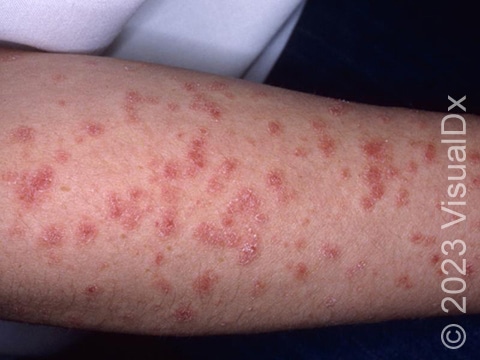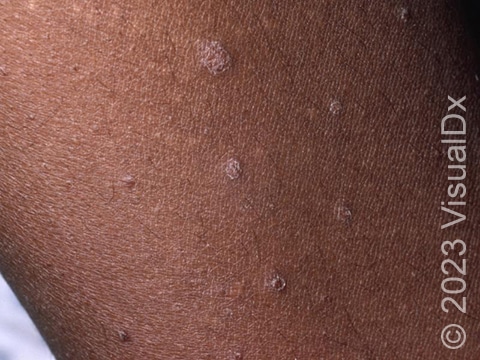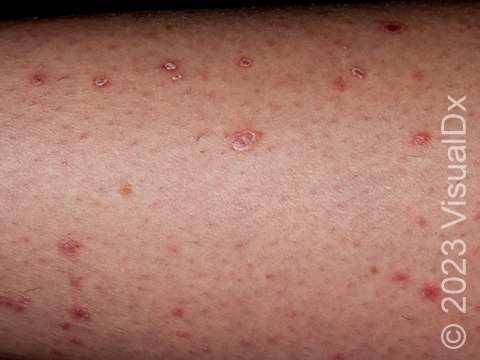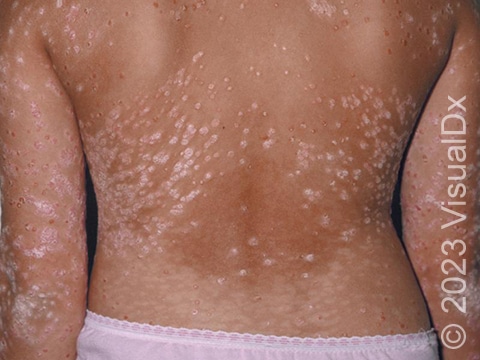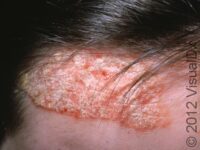
Guttate Psoriasis
Psoriasis is a common, noncontagious condition that can present in a variety of ways in the skin. The different subtypes of this condition include plaque, inverse (or skin fold), guttate, erythrodermic, and pustular psoriasis. Guttate psoriasis is a subtype of psoriasis that typically affects children or young adults, although it can present at any age. Guttate means “drop” in Latin. The rash is described as small, drop- or oval-shaped, red or pink macules (raised skin lesions that are smaller than a thumbnail) with thin white scale. This condition is most commonly triggered by a streptococcal (“strep”) infection. About 80% of individuals with guttate psoriasis have had a strep infection previously, usually in the throat but sometimes on the skin surrounding the anus.
Guttate lesions commonly develop on the arms, legs, and trunk but may become widespread and involve other areas, such as the face, neck, and scalp. Psoriasis, including guttate psoriasis, is thought to be caused by an overactive immune system that attacks the skin, making the skin become thick and dry. Guttate psoriasis may occur in individuals with a prior history of psoriasis. However, it may also occur in those without a history of psoriasis and may be indicative of an increased risk of plaque psoriasis in those affected. Around 50% of people with guttate psoriasis will develop plaque psoriasis later in life.
Unlike plaque psoriasis, guttate psoriasis usually resolves on its own within a few weeks without any treatment, although approximately one-third of individuals may have long-standing disease. Your medical professional may recommend several treatment options to help the skin lesions resolve faster.
Who's At Risk?
Guttate psoriasis can occur in any age, race / ethnicity, and sex, but it is most common in children and in individuals younger than 30 years. It affects men and women equally.
Signs & Symptoms
The most obvious symptoms of guttate psoriasis are small drop-shaped, scaly spots that appear 2-3 weeks after a strep infection (usually infection of the throat or tonsils). In lighter skin colors, the patches are most often pink or red. In darker skin colors, the redness may be harder to see or may appear purple, grayish, or dark brown. The rash may be covered with thin, white, flaky skin. The rash usually starts on the trunk, arms, and legs (extremities) but may extend to large areas of skin, including the face, neck, and scalp. Itching is a common symptom associated with guttate psoriasis.
Self-Care Guidelines
Self-care measures will not cure guttate psoriasis but can help decrease the symptoms, depending on how severe they are.
Taking baths daily can help calm the inflamed skin and help remove the thickened, scaly skin. Avoid hot water, harsh soaps, and scrubbing of the skin, as they may worsen the psoriasis. Moisturizing soaps and soap substitutes, such as unscented Dove Sensitive Skin Beauty Bar, Vanicream Cleansing Bar, and CeraVe Psoriasis Cleanser, are milder products for the skin.
Using an ointment-based moisturizer will help keep the skin moist, especially after a bath. Thicker moisturizers such as petroleum jelly (Vaseline), Aquaphor Healing Ointment, Eucerin Original Healing Cream, Vanicream, Aveeno Moisturizing Cream, CeraVe Healing Ointment, and CeraVe Moisturizing Cream are more moisturizing than water-based lotions and may help with the itching.
Patient Support Resources
The National Psoriasis Foundation is a useful resource for patients and health professionals that has additional information regarding psoriasis and the various available treatments. The National Psoriasis Foundation website includes access to psoriasis-related articles, psoriasis research, a directory of health care professionals with an expertise in psoriasis, and opportunities for patients to volunteer or get involved in upcoming events.
Treatments
The goal of treating guttate psoriasis is to reduce inflammation, thickened skin, and irritation. The choice of treatment should be tailored to the individual, and your medical professional may change treatment depending on how well you respond.
Topical steroids may be prescribed for guttate psoriasis that is not too widespread. There are several different strengths that may be used, depending on the severity and body location. Lower-strength steroids are usually used for sensitive areas such as the face. Stronger steroids may be prescribed for other areas on the body, and the most potent steroids are typically prescribed for thick lesions on the arms and legs or hands and feet. Long-term use or overuse of strong steroids can decrease effectiveness and cause thinning of the skin. To avoid this, do not use topical steroids for periods longer than 2-3 weeks without a 1 week break in between treatments periods.
Vitamin D-related creams may also be prescribed to help reduce symptoms. Calcipotriene is a prescription cream that is commonly prescribed to treat mild-to-moderate psoriasis. Other forms of psoriasis are commonly treated with injectable drugs called biologics, but these are not typically used for guttate psoriasis. In most cases, it is best to avoid steroid pills taken by mouth.
Ultraviolet light therapy (UV), also known as phototherapy, is another option to help improve psoriasis. This treatment can be done with natural or artificial UV light, typically 3-5 times per week. Your medical professional can recommend an appropriate phototherapy regimen.
If the rash persists, oral or injectable biologic medications approved for plaque psoriasis may be used off-label and show very high rates of skin clearance for guttate psoriasis.
Because guttate psoriasis is commonly seen after a strep infection, an antibiotic may be prescribed to patients with bacterial infections. These antibiotics include amoxicillin, penicillin, cefuroxime, and erythromycin. However, antibiotics are only indicated when a bacterial infection is suspected and should not be taken for purposes of treating guttate psoriasis.
Visit Urgency
If symptoms of guttate psoriasis develop and do not improve with time, seek advice from your medical professional. Lesions typically last a few weeks and fade away; however, guttate psoriasis can develop into chronic plaque psoriasis.
References
Bolognia J, Schaffer JV, Cerroni L. Dermatology. 4th ed. Philadelphia, PA: Elsevier; 2018.
James WD, Elston D, Treat JR, Rosenbach MA. Andrew’s Diseases of the Skin. 13th ed. Philadelphia, PA: Elsevier; 2019.
Kang S, Amagai M, Bruckner AL, et al. Fitzpatrick’s Dermatology. 9th ed. New York, NY: McGraw-Hill Education; 2019.
Paller A, Mancini A. Paller and Mancini: Hurwitz Clinical Pediatric Dermatology. 6th ed. St. Louis, MO: Elsevier; 2022.
Last modified on June 26th, 2024 at 11:29 am
Related Skin Conditions


Not sure what to look for?
Try our new Rash and Skin Condition Finder
